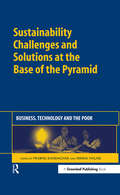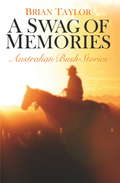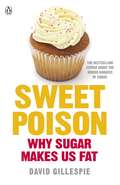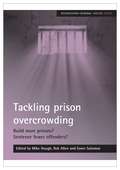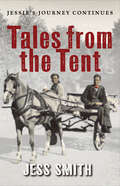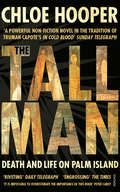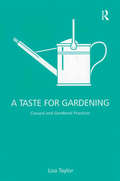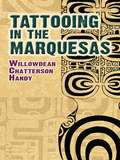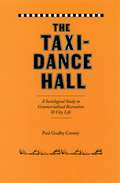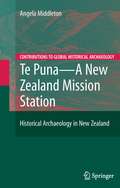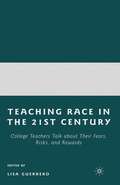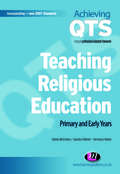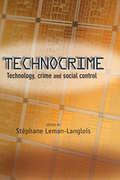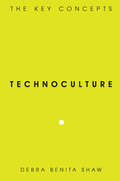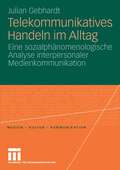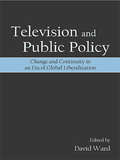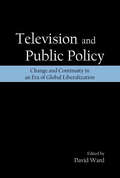- Table View
- List View
Sustainability Challenges and Solutions at the Base of the Pyramid: Business, Technology and the Poor
by Prabhu Kandachar Minna HalmeAround the turn of the millennium it had become painfully evident that development aid, charity or "global business-as-usual" were not going to be the mechanisms to alleviate global poverty. Today, there is little dispute that poverty remains the most pressing global problem calling for innovative solutions. One recent strategy is the Base of the Pyramid (BoP) concept developed by Prahalad and Hart, which relies on entrepreneurial activity tapping into the previously ignored markets of the economically most disadvantaged. It is a process requiring innovations in several disciplines: technological, social and business.This book covers a number of areas. First, much of the current BoP discussion emphasises targeting products to the needs of the poor. But do we actually know what the real needs of the poor are? This book takes a bottom-up human-centred approach and examines examples that truly engage the poor in BoP product and service development. What types of needs assessment methodologies are indicated considering the cultural differences in BoP countries? Are the existing methodologies adequate? Do they need to be redefined and redeveloped? Second, the book considers how we can balance poverty alleviation and stimulate economic growth without stressing the ecosystem. Tragically, the poor are hardest hit by the adverse effects of environmental deterioration such as water shortages, climate change or the destruction of habitats. While the economic welfare of the poor is critical, the BoP approach must balance its inherent paradox of encouraging greater consumption while avoiding further pressures on environmental sustainability. The link between the BoP approach and sustainable development is a key feature of this book. Third, it looks at innovation and asks what kinds of"bottom-up" innovation (open source, technological, social and business) support BoP initiatives (and sustainable development)?Fourth, the book deals with the relationship between development assistance and BoP. Is a BoP strategy the antithesis to development aid or can these two co-exist or even complement each other?Finally, the book raises questions about the relationship between corporate responsibility and BoP. Is BoP a new form of corporate neo-colonialism or a new form of corporate responsibility? Although the BoP concept has unleashed an extensive and generally enthusiastic response from academics, businesses, NGOs and governments, the knowledge domain around this concept is still in the early stages of development. This book addresses that need with a focus on the needs of the end-users – the poor – as a starting point for BoP products and innovations. With contributions from both supporters and critics, it provides a treasure trove of global knowledge on how the concept has developed, what its successes and failures have been and what promise it holds as a long-term strategy for alleviating poverty and tackling global sustainability.
A Swag of Memories: Australian bush stories
by Brian TaylorA quintessential Australian bushman, Brian Taylor has spent most of his life on the land. Working as a drover, a stockman, a fencer, a shearer and a saddler, he has gathered a swag of stories over the years as he travelled way out past the Barcoo, along the dusty plains and beside the dry creek beds under the endless southern sky. In A SWAG OF MEMORIES Brian Taylor shares with us these stories, of the people he has met, the places he has been and the moments, long-gone, that define the traditions of the Australian bush. Like those bush poets and storytellers of days past, Taylor brings to life the characters and the creatures of the bush: men like Dangerous Dan Smith, a hard, self-reliant man who had a gentler talent; Father Peter, a parish priest and occasional hero; Charlie Gibson, an Aboriginal stockman who knew the land better than anyone; and Banjo, the ever-alert dingo watchdog. These colourful and evocative bush tales delightfully capture a slight of Australian life that many of us will never get to see. Luckily, with this collection, you can sit back with a billy of tea and read all about it.
Sweet Poison: Why Sugar Makes Us Fat
by David GillespieUnderstand and break your addiction to sugar with David Gillespie's Sweet Poison. David Gillespie was 6 stone overweight, lethargic and desperate to lose weight fast - but he'd failed every diet out there. When David cut sugar from his diet he immediately started to lose weight and - more amazingly - kept it off. Now slim and with new reserves of energy, David set out to investigate the connection between sugar, our soaring obesity rates and some of the more worrying diseases of the twenty-first century. He discovered: IT'S NOT OUR FAULT WE'RE FAT·Sugar was once such a rare resource that we haven't developed an off-switch - we can keep eating sugar without feeling full.·In the space of 150 years, we have gone from eating no added sugar to more than 2 pounds a week.·Eating that much sugar, you would need to run 4.5 miles every day of your life to not put on weight.·Food manufacturers exploit our sugar addiction by lacing it through 'non-sweet' products like bread, sauces and cereals.In Sweet Poison David Gillespie exposes one of the great health scourges of our time and offers a wealth of practical information on how to quit sugar.David Gillespie is a recovering corporate lawyer, co-founder of a successful software company and consultant to the IT industry. He is also the father of six young children (including one set of twins). With such a lot of extra time on his hands, and 40 extra kilos on his waistline, he set out to investigate why he, like so many in his generation, was fat. He deciphered the latest medical findings on diet and weight gain and what he found was chilling. Being fat was the least of his problems. He needed to stop poisoning himself.
Tackling prison overcrowding: Build more prisons? Sentence fewer offenders? (Researching Criminal Justice series)
by Mike Hough Rob AllenTackling prison overcrowding is a response to controversial proposals for prisons and sentencing set out in by Lord Patrick Carter's Review of Prisons, published in 2007. The Carter review proposed the construction of vast 'Titan' prisons to deal with the immediate problem of prison overcrowding, the establishment of a Sentencing Commission as a mechanism for keeping judicial demand for prison places in line with supply, along with further use of the private sector, including private sector management methods. Tackling prison overcrowding comprises nine chapters by leading academic experts, who expose these proposals to critical scrutiny. They take the Carter Report to task for construing the problems too narrowly, in terms of efficiency and economy, and for failing to understand the wider issues of justice that need addressing. They argue that the crisis of prison overcrowding is first and foremost a political problem - arising from penal populism - for which political solutions need to be found. This accessible report will be of interest to policy makers, probation practitioners, academics and other commentators on criminal policy.
Tagesbetreuung im Wandel: Das Familienzentrum als Zukunftsmodell
by Stephan Rietmann Gregor HensenFamilienzentren erbringen integrative Dienstleistungen für Kinder und Familien, indem sie die Funktionen der Betreuung, Bildung und Beratung verbinden. Die Konzeption und Organisation eines Familienzentrums stellt sich als Gestaltungsaufgabe dar, mit der vielfältige Chancen, Herausforderungen und Probleme verbunden sind. In diesem Sammelband betrachten Fachleute aus Wissenschaft und Praxis das Zukunftsmodell Familienzentrum unter anderem aus erziehungswissenschaftlicher, entwicklungspsychologischer und organisationswissenschaftlicher Perspektive.
Tagesbetreuung im Wandel: Das Familienzentrum als Zukunftsmodell
by Stephan Rietmann Gregor HensenFamilienzentren erbringen integrative Dienstleistungen für Kinder und Familien, indem sie die Funktionen der Betreuung, Bildung und Beratung verbinden. Die Konzeption und Organisation eines Familienzentrums stellt sich als Gestaltungsaufgabe dar, mit der vielfältige Chancen, Herausforderungen und Probleme verbunden sind. In diesem Sammelband betrachten Fachleute aus Wissenschaft und Praxis das Zukunftsmodell Familienzentrum unter anderem aus erziehungswissenschaftlicher, entwicklungspsychologischer und organisationswissenschaftlicher Perspektive.
Tales from the Tent: Jessie's Journey Continues
by Jess SmithIn Tales from the Tent, Jess Smith - Scottish traveller, hawker, gypsy, 'gan-about' and storyteller - continues the unforgettable story started in Jessie's Journey of her life on the road. Unable to adjust to settled life working in a factory after leaving school, she finds herself drawn once again to the wild countryside of Scotland. Having grown up on the road in an old blue bus with her parents and seven sisters, Jessie now joins her family in caravans, stopping to rest in campsites and lay-bys as they follow work around the country - berry-picking, hay-stacking, ragging, fortune-telling and hawking. Making the most of their freedom, Jessie and her family continue the traditional way of life that is disappearing before their eyes, wandering the roads and byways, sharing tales and living on the edge of 'acceptable' society. Intertwined with the story of Jessie's loveable but infuriating family, incorrigible friends, first loves and first losses are her 'tales from the tent', a collection of folklore from the traveller's world, tales of romance, mythical beasts, dreams, ghostly apparitions and strange encounters.
The Tall Man: Death and Life on Palm Island
by Chloe HooperWhen Cameron Doomadgee, a 36-year-old member of the Aboriginal community of Palm Island, was arrested for swearing at a white police officer, he was dead within forty-five minutes of being locked up. The police claimed he'd tripped on a step, but the pathologist likened his injuries to those received in a plane crash. The main suspect was the handsome, charismatic Senior Sergeant Christopher Hurley, an experienced cop with decorations for his work. In following Hurley's trail to some of the wildest and most remote parts of Australia, Chloe Hooper explores Aboriginal myths and history and uncovers buried secrets of white mischief. Atmospheric, gritty and original, The Tall Man takes readers to the heart of a struggle for power, revenge and justice.
A Taste for Gardening: Classed and Gendered Practices
by Lisa TaylorIs the garden a consumption site where identities are constructed? Do gardeners make aesthetic choices according to how they are positioned by class and gender? This book presents the first scholarly analysis of the relationship between media interest in gardening and cultural identities. With an examination of aesthetic dispositions as a symbolic mode of communication closely aligned to peoples' identities and drawing on ethnographic data gathered from encounters with gardeners, this book maps a typology of gardening taste, revealing that gardening - how plants are chosen, planted and cared for - is a classed and gendered practice manifested in specific types of visual aesthetics. This timely and original book develops a new area within cultural studies while contributing to debates about lifestyle and lifestyle media, consumption, class and methodology. A must read for anybody concerned with or intrigued by the cultural construction of identification practices.
A Taste for Gardening: Classed and Gendered Practices
by Lisa TaylorIs the garden a consumption site where identities are constructed? Do gardeners make aesthetic choices according to how they are positioned by class and gender? This book presents the first scholarly analysis of the relationship between media interest in gardening and cultural identities. With an examination of aesthetic dispositions as a symbolic mode of communication closely aligned to peoples' identities and drawing on ethnographic data gathered from encounters with gardeners, this book maps a typology of gardening taste, revealing that gardening - how plants are chosen, planted and cared for - is a classed and gendered practice manifested in specific types of visual aesthetics. This timely and original book develops a new area within cultural studies while contributing to debates about lifestyle and lifestyle media, consumption, class and methodology. A must read for anybody concerned with or intrigued by the cultural construction of identification practices.
Tattooing in the Marquesas
by Willowdean Chatterson HandyThis definitive source on the intricate tattoos of Polynesia's Marquesas Islands offers a rare glimpse of a dying art. Because of the colonial authorities' 1884 ban on tattooing, there remained only a single surviving tattoo artist at the time of this 1921 survey—and a dwindling number of living examples. These 38 plates of black-and-white drawings and photographs provide an unusually complete and intimate record of a sophisticated art form.The Marquesas consist of a dozen rugged volcanic islands that lie 1,000 miles northeast of Tahiti. Rich in oral traditions, folklore, and decorative arts, their complex culture was devastated by the intrusions of outsiders during the nineteenth century. In the early 1920s, Hawaii's Bishop Museum sponsored an expedition to preserve what was left of the islanders' vanishing world. Willowdean Chatterson Handy, an expedition associate, created this priceless record of the ancient body art rituals. In addition to detailed information about tattoo methods and customs, Handy's account features fascinating insights into the designs' symbolic significance and their representation of social status. Her painstaking drawings of tattoo patterns are accompanied by captions that explain the traditional motifs.
The Taxi-Dance Hall: A Sociological Study in Commercialized Recreation and City Life (University of Chicago Sociological Series #No. 76)
by Paul Goalby CresseyFirst published in 1932, The Taxi-Dance Hall is Paul Goalby Cressey’s fascinating study of Chicago’s urban nightlife—as seen through the eyes of the patrons, owners, and dancers-for-hire who frequented the city’s notoriously seedy “taxi-dance” halls. Taxi-dance halls, as the introduction notes, were social centers where men could come and pay to dance with “a bevy of pretty, vivacious, and often mercenary” women. Ten cents per dance was the usual fee, with half the proceeds going to the dancer and the other half to the owner of the taxi-hall. Cressey’s study includes detailed maps of the taxi-dance districts, illuminating interviews with dancers, patrons, and owners, and vivid analyses of local attempts to reform the taxi-dance hall and its attendees. Cressey’s study reveals these halls to be the distinctive urban consequence of tensions between a young, diverse, and economically independent population at odds with the restrictive regulations of Prohibition America. Thick with sexual vice, ethnic clashes, and powerful undercurrents of class, The Taxi-Dance Hall is a landmark example of Chicago sociology, perfect for scholars and history buffs alike.
The Taxi-Dance Hall: A Sociological Study in Commercialized Recreation and City Life (University of Chicago Sociological Series)
by Paul Goalby CresseyFirst published in 1932, The Taxi-Dance Hall is Paul Goalby Cressey’s fascinating study of Chicago’s urban nightlife—as seen through the eyes of the patrons, owners, and dancers-for-hire who frequented the city’s notoriously seedy “taxi-dance” halls. Taxi-dance halls, as the introduction notes, were social centers where men could come and pay to dance with “a bevy of pretty, vivacious, and often mercenary” women. Ten cents per dance was the usual fee, with half the proceeds going to the dancer and the other half to the owner of the taxi-hall. Cressey’s study includes detailed maps of the taxi-dance districts, illuminating interviews with dancers, patrons, and owners, and vivid analyses of local attempts to reform the taxi-dance hall and its attendees. Cressey’s study reveals these halls to be the distinctive urban consequence of tensions between a young, diverse, and economically independent population at odds with the restrictive regulations of Prohibition America. Thick with sexual vice, ethnic clashes, and powerful undercurrents of class, The Taxi-Dance Hall is a landmark example of Chicago sociology, perfect for scholars and history buffs alike.
The Taxi-Dance Hall: A Sociological Study in Commercialized Recreation and City Life (University of Chicago Sociological Series #No. 76)
by Paul Goalby CresseyFirst published in 1932, The Taxi-Dance Hall is Paul Goalby Cressey’s fascinating study of Chicago’s urban nightlife—as seen through the eyes of the patrons, owners, and dancers-for-hire who frequented the city’s notoriously seedy “taxi-dance” halls. Taxi-dance halls, as the introduction notes, were social centers where men could come and pay to dance with “a bevy of pretty, vivacious, and often mercenary” women. Ten cents per dance was the usual fee, with half the proceeds going to the dancer and the other half to the owner of the taxi-hall. Cressey’s study includes detailed maps of the taxi-dance districts, illuminating interviews with dancers, patrons, and owners, and vivid analyses of local attempts to reform the taxi-dance hall and its attendees. Cressey’s study reveals these halls to be the distinctive urban consequence of tensions between a young, diverse, and economically independent population at odds with the restrictive regulations of Prohibition America. Thick with sexual vice, ethnic clashes, and powerful undercurrents of class, The Taxi-Dance Hall is a landmark example of Chicago sociology, perfect for scholars and history buffs alike.
The Taxi-Dance Hall: A Sociological Study in Commercialized Recreation and City Life (University of Chicago Sociological Series)
by Paul Goalby CresseyFirst published in 1932, The Taxi-Dance Hall is Paul Goalby Cressey’s fascinating study of Chicago’s urban nightlife—as seen through the eyes of the patrons, owners, and dancers-for-hire who frequented the city’s notoriously seedy “taxi-dance” halls. Taxi-dance halls, as the introduction notes, were social centers where men could come and pay to dance with “a bevy of pretty, vivacious, and often mercenary” women. Ten cents per dance was the usual fee, with half the proceeds going to the dancer and the other half to the owner of the taxi-hall. Cressey’s study includes detailed maps of the taxi-dance districts, illuminating interviews with dancers, patrons, and owners, and vivid analyses of local attempts to reform the taxi-dance hall and its attendees. Cressey’s study reveals these halls to be the distinctive urban consequence of tensions between a young, diverse, and economically independent population at odds with the restrictive regulations of Prohibition America. Thick with sexual vice, ethnic clashes, and powerful undercurrents of class, The Taxi-Dance Hall is a landmark example of Chicago sociology, perfect for scholars and history buffs alike.
Te Puna - A New Zealand Mission Station: Historical Archaeology in New Zealand (Contributions To Global Historical Archaeology)
by Angela MiddletonEvangelical missionary societies have been associated with the processes of colonisation throughout the globe, from India to Africa and into the Pacific. In late 18th-century Britain, the Church Missionary Society for Africa and the East (CMS) began its missionary ventures, and in the first decade of the 19th-century, sent three of its members to New South Wales, Australia, and then on to New Zealand, an unknown, little-explored part of the world. Across the globe, a common material culture travelled with its evangelizing (and later colonizing) settlers, with artefacts appearing as cultural markers from Cape Town in South Africa, to Tasmania in Australia and the even more remote Bay of Islands in New Zealand. After missionization, colonization occurred. Additionally, common themes of interaction with indigenous peoples, household economy, the development of commerce, and social and gender relations also played out in these communities. This work is unique in that it provides the first archaeological examination of a New Zealand mission station, and as such, makes an important contribution to New Zealand historical archaeology and history. It also situates the case study in a global context, making a significant contribution to the international field of mission archaeology. It informs a wider audience about the processes of colonization and culture contact in New Zealand, along with the details of the material culture of the country’s first European settlers, providing a point of comparison with other outposts of British colonization.
Teaching Race in the 21st Century: College Teachers Talk about Their Fears, Risks, and Rewards
by L. GuerreroThis collection brings together pedagogical memoirs on significant topics regarding teaching race in college, including student resistance, whiteness, professor identity, and curricula. Linking theory to practice, the essays create an accessible and useful way to look at teaching race for wide audiences interested in issues within education.
Teaching Religious Education: Primary and Early Years
by Elaine Mccreery Sandra Palmer Veronica M VoielsMany trainee primary teachers are uncertain as to the place and purpose of RE in primary schools. This book is designed to alleviate such fears and give trainees the security and confidence to teach RE effectively. Trainees are encouraged to recognise their own religious position and understand how they handle their own beliefs and commitments in the classroom. In addition, they will learn how to be sensitive to children's religious viewpoints, allowing children to share their beliefs in a secure and supportive environment. A range of strategies help readers to provide engaging and appropriate RE across the primary age phase.
Technocrime: Technology, Crime and Social Control (PDF)
by Stéphane Leman-LangloisThis book is concerned with the concept of 'technocrime'. The term encompasses crimes committed on or with computers - the standard definition of cybercrime - but it goes well beyond this to convey the idea that technology enables an entirely new way of committing, combating and thinking about criminality, criminals, police, courts, victims and citizens. Technology offers, for example, not only new ways of combating crime, but also new ways to look for, unveil, and label crimes, and new ways to know, watch, prosecute and punish criminals. Technocrime differs from books concerned more narrowly with cybercrime in taking an approach and understanding of the scope of technology's impact on crime and crime control. It uncovers mechanisms by which behaviours become crimes or cease to be called crimes. It identifies a number of corporate, government and individual actors who are instrumental in this construction. And it looks at the beneficiaries of increased surveillance, control and protection as well as the targets of it. Chapters in the book cover specific technologies (e.g. the use of CCTV in various settings; computers, hackers and security experts; photo radar) but have a wider objective to provide a comparative perspective and some broader theoretical foundations for thinking about crime and technology than have existed hitherto. This is a pioneering book which advances our understanding of the relationship between crime and technology, drawing upon the disciplines of criminology, political science, sociology, psychology, anthropology, surveillance studies and cultural studies.
Technocrime: Technology, Crime and Social Control
by Stéphane Leman-LangloisThis book is concerned with the concept of 'technocrime'. The term encompasses crimes committed on or with computers - the standard definition of cybercrime - but it goes well beyond this to convey the idea that technology enables an entirely new way of committing, combating and thinking about criminality, criminals, police, courts, victims and citizens. Technology offers, for example, not only new ways of combating crime, but also new ways to look for, unveil, and label crimes, and new ways to know, watch, prosecute and punish criminals. Technocrime differs from books concerned more narrowly with cybercrime in taking an approach and understanding of the scope of technology's impact on crime and crime control. It uncovers mechanisms by which behaviours become crimes or cease to be called crimes. It identifies a number of corporate, government and individual actors who are instrumental in this construction. And it looks at the beneficiaries of increased surveillance, control and protection as well as the targets of it. Chapters in the book cover specific technologies (e.g. the use of CCTV in various settings; computers, hackers and security experts; photo radar) but have a wider objective to provide a comparative perspective and some broader theoretical foundations for thinking about crime and technology than have existed hitherto. This is a pioneering book which advances our understanding of the relationship between crime and technology, drawing upon the disciplines of criminology, political science, sociology, psychology, anthropology, surveillance studies and cultural studies.
Technoculture: The Key Concepts
by Debra Benita ShawWe live in a world where science and technology shape the global economy and everyday culture, where new biotechnologies are changing what we eat and how we can reproduce, and where email, mobiles and the internet have revolutionised the ways we communicate with each other and engage with the world outside us.Technoculture: The Key Concepts explores the power of scientific ideas, their impact on how we understand the natural world and how successive technological developments have influenced our attitudes to work, art, space, language and the human body. Throughout, the lively discussion of ideas is illustrated with provocative case studies - from biotech foods to life-support systems, from the Walkman and iPod to sex and cloning, from video games to military hardware. Designed to be both provocative and instructive, Technoculture: The Key Concepts outlines the place of science and technology in today's culture.
Technoculture: The Key Concepts (The\key Concepts Ser.)
by Debra Benita ShawWe live in a world where science and technology shape the global economy and everyday culture, where new biotechnologies are changing what we eat and how we can reproduce, and where email, mobiles and the internet have revolutionised the ways we communicate with each other and engage with the world outside us.Technoculture: The Key Concepts explores the power of scientific ideas, their impact on how we understand the natural world and how successive technological developments have influenced our attitudes to work, art, space, language and the human body. Throughout, the lively discussion of ideas is illustrated with provocative case studies - from biotech foods to life-support systems, from the Walkman and iPod to sex and cloning, from video games to military hardware. Designed to be both provocative and instructive, Technoculture: The Key Concepts outlines the place of science and technology in today's culture.
Telekommunikatives Handeln im Alltag: Eine sozialphänomenologische Analyse interpersonaler Medienkommunikation (Medien • Kultur • Kommunikation)
by Julian GebhardtZiel der Arbeit ist es, die kommunikationswissenschaftliche Analyse der alltäglichen Aneignung und Nutzung von Medien der interpersonalen Telekommunikation auf eine neue grundlagentheoretische Basis zu stellen. Gegen die dominante Sicht technikdeterministischer Ansätze wird die zwischenmenschliche Genese und Einbettung medialer kommunikativer Handlungspraktiken auf die fundamentalen Ausgangsprobleme ihrer sozialen und damit intersubjektiven Verfasstheit rückbezogen. Aufbauend auf der Sozialphänomenologie von Alfred Schütz (und Thomas Luckmann) werden die basalen intersubjektiven Konstitutionsbedingungen interpersonaler Medienkommunikation herausgearbeitet und so ein besseres Verständnis der Sozialitätsbedingungen von Medien und medialer Kommunikationspraktiken ermöglicht. Die Arbeit konstituiert eine handlungstheoretisch begründete und alltagsweltlich fundierte Analyseperspektive, vor deren Hintergrund sich die auf diesem Feld vorliegenden Forschungsansätze einordnen, präzisieren und weiter entwickeln lassen.
Television and Public Policy: Change and Continuity in an Era of Global Liberalization
by David WardThe significant changes that have swept the television industry over the last two decades, most notably a shift to deregulation in broadcast media, prompt a discussion on how to ensure that meaningful content is available to the viewer. Television and Public Policy analyzes the current state of television systems in a selected group of countries by exploring the political, economic, and technological factors that have shaped the sector in such a short span of time. Consequently, by positioning the television sector within issues of media policy and the regulatory framework, the book questions what these trends mean for television, and the historical, political, and cultural role in our societies. Television and Public Policy distinguishes itself in several ways:*It is a global project in its comparative scope and subject area. Contributors represent countries including Australia, Brazil, Canada, China, Egypt, India, Iran, Ireland, Israel, Italy, Japan, the Netherlands, New Zealand, Poland, the United Kingdom, and the United States.*It is contemporary and filled with information largely absent in current literature.*It offers original analysis of the contemporary television sector. This book speaks to a broad range of academics, postgraduate, and undergraduate students, and can serve as a key resource for courses ranging from media studies, to development studies, international relations, and law.
Television and Public Policy: Change and Continuity in an Era of Global Liberalization
by David WardThe significant changes that have swept the television industry over the last two decades, most notably a shift to deregulation in broadcast media, prompt a discussion on how to ensure that meaningful content is available to the viewer. Television and Public Policy analyzes the current state of television systems in a selected group of countries by exploring the political, economic, and technological factors that have shaped the sector in such a short span of time. Consequently, by positioning the television sector within issues of media policy and the regulatory framework, the book questions what these trends mean for television, and the historical, political, and cultural role in our societies. Television and Public Policy distinguishes itself in several ways:*It is a global project in its comparative scope and subject area. Contributors represent countries including Australia, Brazil, Canada, China, Egypt, India, Iran, Ireland, Israel, Italy, Japan, the Netherlands, New Zealand, Poland, the United Kingdom, and the United States.*It is contemporary and filled with information largely absent in current literature.*It offers original analysis of the contemporary television sector. This book speaks to a broad range of academics, postgraduate, and undergraduate students, and can serve as a key resource for courses ranging from media studies, to development studies, international relations, and law.
